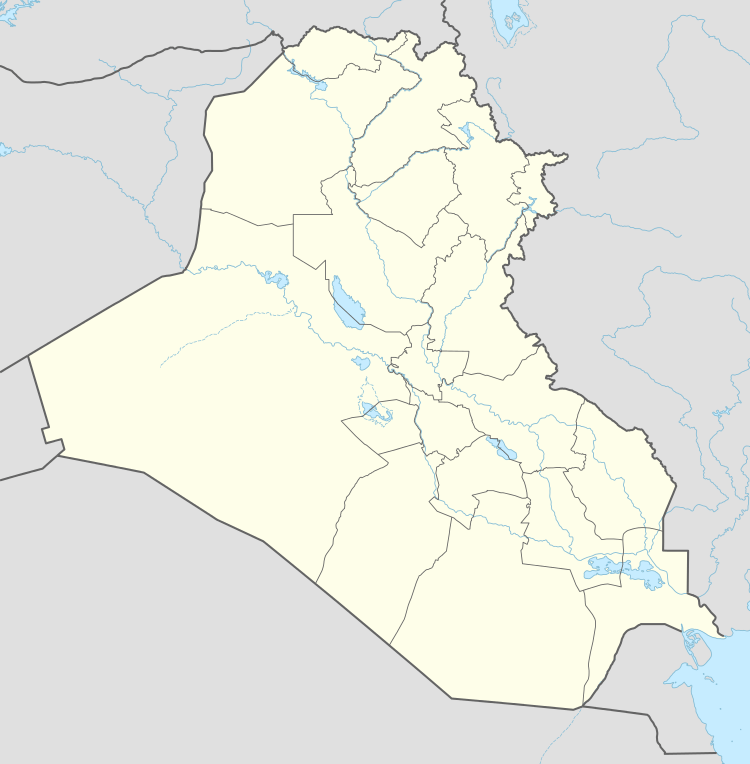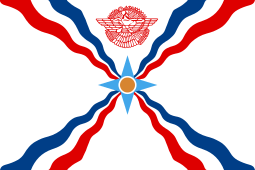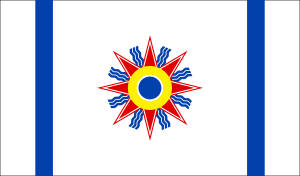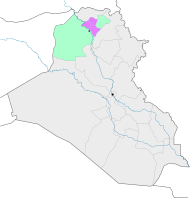Bakhdida
Bakhdida (Syriac: ܒܓ݂ܕܝܕܐ Arabic: بخديدا) Syriac pronunciation: [bɑχdɛːdə], also known as Baghdeda, Qaraqosh, or Al-Hamdaniya, is an Assyrian[4] city in northern Iraq within the Nineveh Governorate, located about 32 km (20 mi) southeast of the city of Mosul and 60 km west of Erbil amid agricultural lands, close to the ruins of the ancient Assyrian cities Nimrud and Nineveh. It is connected to the main city of Mosul by two main roads. The first runs through the towns of Bartella and Karamles which connects to the city of Erbil as well. The second, which was gravel until being paved in the 1990s, is direct to Mosul. All of its citizens fled to Kurdistan Region after the ISIS invasion on August 6, 2014. The town was under control of ISIS until October 19, 2016 when it was liberated as part of the Battle of Mosul after which residents have begun to return.[5]
Bakhdida ܒܓ݂ܕܝܕܐ | |
|---|---|
A view of Bakhdida | |
| Nickname(s): Qaraqosh ܩܪܩܘ݂ܫ | |
 Bakhdida | |
| Coordinates: 36°16′11″N 43°22′39″E | |
| Country | |
| Governorate | Ninawa |
| Municipality | Al-Hamdaniya District |
| Government | |
| • Mayor | Nisan Karromi |
| Population | |
| • Total | 35,000 (current)[1][2] |
| 50,000 (prior to ISIS invasion)[3][2] | |
Etymology
The name Bakhdida (Syriac: ܒܝܬ ܟܘܕܝܕܐ; Beth Khdeda), is of uncertain origin and when translated from the Syriac language it has two components Beth which means "house", and Khodida which could either mean "Youths" in Aramaic or actually "Baghdadak" a diminutive form of Baghdad, Old Persian meaning "God's gift.". Some also believe that Bakhdida comes from the Aramaic Beth Deta, meaning "Land of the Kite".[6]
Situation of the town
Agriculture was the main source of living for the people of Bakhdida. It also prospered on handicrafts such as weaving and producing leather coats which are locally known as Farawee made of sheepskin. Today, Bakhdida has become a center of trade and business with many roads, shops, houses, buildings and many government employees but agriculture and farming remain the main sources of living as since the 1980s many people own and run chicken farms with modern facilities.
The vast majority of its inhabitants are ethnic Assyrians, more than 70% of whom are members of the Syriac Catholic Church, while the rest are Syriac Orthodox. The recent wave of violence targeting Christians in Iraq forced many Assyrians living in major Iraqi cities to move to Assyrian towns in the Nineveh Plains, which swelled the town with an influx of refugees mainly belonging to the Chaldean Catholic Church.
The main language spoken is the Nineveh Plains variant of Syriac, which is almost identical to that spoken in other major towns (like Alqosh and Tel Kepe) in the region. Arabic is also used as a second language. English is widely understood by younger generations.
Security
As of October 2016, the city is under the control of the Nineveh Plain Protection Units.[7] On November 25, 2017; Nineveh Plain Protection Units (NPU) celebrated the completion of its new military camp in Bakhdida, Nineveh Plain.[8]
Education
Students from the village were harassed in University of Mosul; many female students were forced to wear an Islamic dress for fear of being attacked.[9] On 2 May 2010 a convoy of buses carrying students from Bakhdida to University of Mosul was the target of a coordinated attack which killed and injured more than a hundred.[10][11]
The Iraqi Ministry of Education started the construction of a subsidiary of the University of Mosul which in 2014 became the University of Bakhdida which is planned to serve the whole Nineveh Plains region.[12]
History
Pre-Christian accounts
_~_Assyrian_Empire_%2B_Lamassu%2C_Gates_at_Balawat%2C_Relief_Panel's_%26_Full_Projection.3.jpg)
It is thought that the ancient city of Rasin mentioned in some texts, the second city built by the Assyrian king Nimrud, was in Bakhdida.[13]
Early Christian history
The Assyrians of Bakhdida became Christians during early Christianity. With the Christological disputes of the 4th century, they followed the Church of the East teaching but switched to the Syriac Orthodox Church through the influence of Shapur of Baghdeda in the 7th century and the arrival of Assyrian refugees from Tikrit in the 11th century.[14]
Raids of Persians and Kurds
In their literature and writings, the Assyrians of Bakhdida remember vividly the raids of the Persians and Kurds on their village and churches. In 1171, while the governors of Mosul and Damascus were fighting each other, the Kurds used the opportunity to attack the Mar Mattai Monastery.[15] According to the 13th century writer Bar Hebraeus, in 1261 the Kurds came down to Mosul, killing many Christians who refused to follow Islam and looting their homes and churches. The Kurds then occupied the nunnery of Naqortaya and killed many of the nuns and others who had sought refuge there. In 1288 a battle took place between the Kurds and Tatars near Baghdida. In 1324 Baghdida was attacked by the Kurds again and many homes and four churches were burned.[16]
Persian–Ottoman wars
In the early 18th century, Persians under the leadership of Nader Shah invaded the Mosul region and most of the inhabitants of Baghdida escaped to Mosul with all their valuables, in accordance with the governor's orders. Mosul was harassed and then besieged for months. However, the Christians defended it and after months of blockade, the Persians finally signed a peace agreement with Mosul's governor Hasan Pasha Al Jalili, and withdrew in 1743. To reward the Christians for their bravery, the Jalili governor permitted many churches in the Mosul region to be restored.[17]
After the US invasion
Politics since 2005
The people of Bakhdida got the chance to vote for the first time on 30 January 2005. The secular Ayad Allawi led the votes in the town.[18] However many Assyrians, Shabaks and Yazidis were not allowed to vote, which led to demonstrations against the results.[19]
| Ayad Allawi Secular list | 3,080 | 31% |
| Nahrain list (Assyrian list) | 2,664 | 27% |
| Assyrian Democratic Movement | 2,466 | 25% |
| Kurdistan Alliance | 744 | 7% |
The next parliamentary elections on 7 March 2010 saw the rise of local candidates with the Assyrian Democratic Movement coming second. Only 52% of registered voters participated in this election.[20] Due to the rise of extremism in Iraq shortly after the US-led invasion, many of the villagers in Mosul and Baghdad were targeted for being Christians.[21]
On 22 Nov. 2006 Yeshu' Hadaya, the leader of a National Syriac movement was assassinated in Bakhdida.[22]
Islamist attacks and invasion
At the beginning of July 2014, ISIL forces attempted to occupy the city. The Kurdish Peshmerga and the Assyrian Qaraqosh Protection Committee successfully defended it, while elders, women, and children fled to neighboring towns, thus joining other Christian refugees from nearby Mosul that had previously escaped the city in fear of the extremists.[23] The Islamists proceeded to cut off the town's water supply. This, together with the rise in the price of oil following ISIL's invasion of nearby oil field and an embargo imposed by ISIL forcing nearby Muslim villages to stop trade with Bakhdida, rendered life difficult in the town also burdened with incoming refugees.[24] On 6 August 2014, the Kurdish troops withdrew from the city and the next day Islamists from ISIL invaded the city.[25] Much of the population, including recent arrivals, was left joining the 150,000 Assyrians fleeing, though they were forced to walk towards Erbil without their cars and possessions as Kurdish forces feared Islamist infiltration.[26]
All of its citizens fled to Kurdistan Region after the ISIL invasion on August 6, 2014. The town was under control of ISIL until October 19, 2016 when it was liberated as part of the Battle of Mosul.[27]
Currently, NPU run the security profile in the city and participated alongside the Iraqi Army in the liberation efforts of the city.[28]
Climate
Bakhdida has a hot-summer Mediterranean climate (Köppen climate classification Csa). Most rain falls in the winter. The average annual temperature in Bakhdida is 20.7 °C (69.3 °F). About 468 mm (18.43 in) of precipitation falls annually.
| Climate data for Bakhdida | |||||||||||||
|---|---|---|---|---|---|---|---|---|---|---|---|---|---|
| Month | Jan | Feb | Mar | Apr | May | Jun | Jul | Aug | Sep | Oct | Nov | Dec | Year |
| Average high °C (°F) | 12.6 (54.7) |
14.9 (58.8) |
18.6 (65.5) |
24.6 (76.3) |
32.1 (89.8) |
38.8 (101.8) |
42.7 (108.9) |
42.5 (108.5) |
38.2 (100.8) |
30.8 (87.4) |
21.9 (71.4) |
14.7 (58.5) |
27.7 (81.9) |
| Average low °C (°F) | 2.1 (35.8) |
3.6 (38.5) |
6.3 (43.3) |
10.6 (51.1) |
15.8 (60.4) |
20.0 (68.0) |
23.4 (74.1) |
22.5 (72.5) |
17.9 (64.2) |
12.6 (54.7) |
8.3 (46.9) |
3.5 (38.3) |
12.2 (54.0) |
| Average precipitation mm (inches) | 78 (3.1) |
79 (3.1) |
88 (3.5) |
64 (2.5) |
25 (1.0) |
0 (0) |
0 (0) |
0 (0) |
1 (0.0) |
15 (0.6) |
49 (1.9) |
69 (2.7) |
468 (18.4) |
| Source: Climate-Data.org,Climate data | |||||||||||||
Archaeology
Since the late 19th century various locations on the outskirts of the town were excavated by Hormuzd Rassam. In Balawat (the ancient Assyrian city of Imgur-Enlil) a number of Assyrian artifacts have been excavated; they are currently displayed in the British Museum and Mosul Museum.[30] There is a lot of interest in the archaeology of Baghdida today. It has many Assyrian remains, like those of Tel Bashmoni (Beth Shmoni), Tel Muqortaya, Tel Karamles, Tel Mar Bihnam and others. These mounds were fortresses, temples or buildings that belonged to the Assyrian capital of Nimrud. Throughout 1922, 1927, and 1935, archaeologists found gold pieces and cylinder seals, as well as an Assyrian statue (now in Mosul museum) in a well in the church of Mar Zina. In 1942 an Assyrian bathroom and several graves were found near the church of Bashmoni. Furthermore, during the 1980s excavations in the grounds of the Church of Mar Youhanna (Saint John), archaeologists found human remains inside graves in the eastern side and at a depth of one and a half metres. These graves were built with typical Assyrian large rectangular bricks.
References to Athur (Assyria) continued in texts from Baghdeda. Mapharian Athanasius Ibrahim II of Tur Abdin visited Tikrit, Baghdad, and Arbil to attend to his congregation. According to Afram Abdal al-Khouri and his book al-Lu'lu' al-Nadheed fi Tareekh Deir Mar Bihnam al-Shaheed (The Layers of Pearls in the History of the Monastery of Martyred Mar Bihnam), 1951, p. 219, Sony writes: "in 1365 the Mapharian came to Athur or Mosul and was welcomed by Nour al-Din the Chief of Baghdeda … " (Sony 1998, 699). Last but not least, Sony writes that in 1294–1295 (according to the Mar Bihnam monastery archives) a certain king "came to Lower Athur, the city of Saint Mar Bihnam … " (Sony 1998, 95).
References
- Hanna, Reine (September 26, 2019). "Testimony for the U.S. Commission on International Religious Freedom Religious Minorities' Fight to Remain in Iraq" (PDF). United States Commission on International Religious Freedom. Retrieved August 2, 2020.
In the town of Bakhdida, for example, approximately 35,000 Christian Assyrian inhabitants have returned—70% of the town’s original population
- Hanna, Reine (June 1, 2020). "Contested Control: The Future of Security in Iraq's Nineveh Plain" (PDF). Assyrian Policy Institute. p. 42. Retrieved June 27, 2020.
- Taylor, Alan (April 27, 2017). "Iraqi Christians Slowly Return to War-Damaged Qaraqosh". The Atlantic. Retrieved August 2, 2020.
- Castillo, Mariano (August 9, 2014). "ISIS overtakes Iraq's largest Christian city". CNN International. Retrieved August 2, 2020.
- Talat, Mahdi (30 October 2016). "In charred church near Mosul, Iraqi Christians pray once more". Reuters. Retrieved 31 October 2016.
- اصول أسماء القرى والمواقع التابعة لمنطقة بخديدا, بهنام عطاالله
- Stancati, Margherita (December 6, 2016). "Iraq's Christians Turn to Militia for Protection". The Wall Street Journal. Retrieved August 2, 2020.
- "Completion of the NPU Camp In Bakhdeda, Nineveh Plain". Zowaa.org. December 5, 2017.
- "Assyrian University Students Beaten By Iraqi Police". Christiansofiraq.com. Archived from the original on 20 November 2010. Retrieved 2010-12-01.
- Bombs Hit School Buses in North Iraq, SAM DAGHER, The New York Times
- "IRAQ Car bomb targets Christian student's bus near Mosul - Asia News". Asianews.it. 2009-11-14. Retrieved 2010-12-01.
- Schmidinger, Thomas (2019). Die Welt hat uns vergessen. Mandelbaum Verlag. p. 67. ISBN 9783854765905.
- George, Nashwan. Södertälje. Ankawa: Ishtar TV. p. 21.
- "Baghdede". Ishtar Broadcasting Corporation. December 16, 2011. Retrieved August 2, 2020.
- The chronography of Gregory Abû'l Faraj, the son of Aaron, the Hebrew physician
- Bar Hebraius, Summary of the History of the lands, Arabic edition P. 492-497
- Ghassan Hanna. "Bakhdida". Chaldeansonline.org. Retrieved 2010-12-01.
- Ankawa.con. "الاف الغديداي يتوجهون الى مراكز الاقتراع للاشتراك في الانتخابات وقائمة النهرين وطني تأتي في المرتبة الثانية". Ankawa.com. Retrieved 2010-12-01.
- "Assyrian Christians of Iraq Wanted to Vote But Were Not Allowed". Aina.org. 2005-02-27. Archived from the original on 2 December 2010. Retrieved 2010-12-01.
- سير الأنتخابات في مراكز بغديدا وكرمليس, منظمة حمورابي لحقوق الأنسان
- "New Archbishop of Mosul calls persecuted Iraqi Christians to hope :: Catholic News Agency (CNA)". Catholic News Agency. 2010-01-27. Retrieved 2010-12-01.
- "مسيحيـــــو العـــــراق وتحديـــــات البقـــــاء". Election.elmarada.org. Retrieved 2010-12-01.
- As reported by Frankfurter Allgemeine (in German language)
- [Iraq's Waterless Christians: The Campaign to Expel a Religion Business Week: Iraq's Waterless Christians: The Campaign to Expel a Religion]
- As reported by Le Figaro (in French language)
- As reported by Radio Vatican (in French language)
- Talat, Mahdi (30 October 2016). "In charred church near Mosul, Iraqi Christians pray once more". Reuters. Retrieved 31 October 2016.
- "Iraq: Looting, Destruction by Forces Fighting ISIS". Human Rights Watch. February 16, 2017. Retrieved August 2, 2020.
- "No Mass said in Mosul for first time in 1,600 years, says Archbishop" (Archive). Christian Today. 28 June 2014. Retrieved on 7 July 2014.
- "Balawat (ancient Imgur-Enlil, Iraq)". British Museum. Retrieved 2010-12-01.
External links
- http://www.ishtartv.com/en/viewarticle,35746.html—Service%5B%5D and Construction for the city - 2011-12-16



